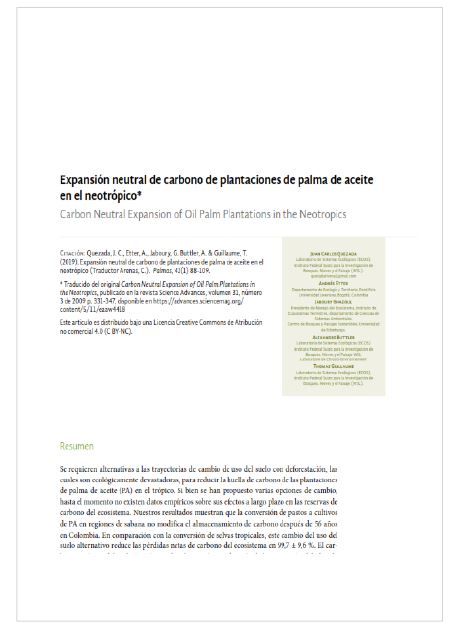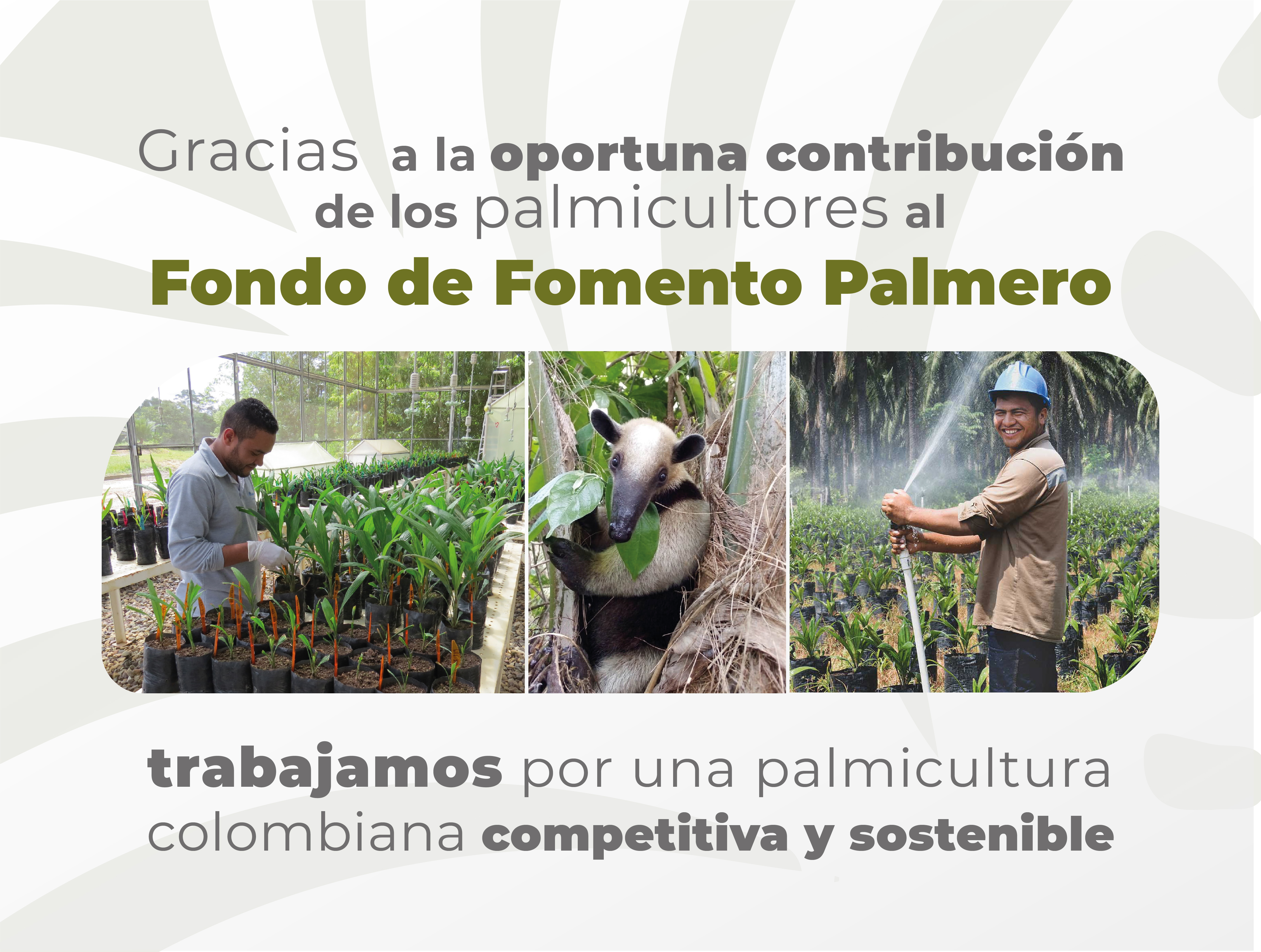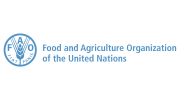Expansión neutral de carbono de plantaciones de palma de aceite en el neotrópico
Palabras clave:
uso del suelo, deforestación, huella de carbonoResumen
Se requieren alternativas a las trayectorias de cambio de uso del suelo con deforestación, las cuales son ecológicamente devastadoras, para reducir la huella de carbono de las plantaciones de palma de aceite (PA) en el trópico. Si bien se han propuesto varias opciones de cambio, hasta el momento no existen datos empíricos sobre sus efectos a largo plazo en las reservas de carbono del ecosistema. Nuestros resultados muestran que la conversión de pastos a cultivos de PA en regiones de sabana no modifica el almacenamiento de carbono después de 56 años en Colombia. En comparación con la conversión de selvas tropicales, este cambio del uso del suelo alternativo reduce las pérdidas netas de carbono del ecosistema en 99,7 ± 9,6 %. El carbono orgánico del suelo (COS) se redujo hasta 36 años después de la conversión debido a la rápida descomposición del carbono derivado de pastos, contrarrestando las ganancias de este en la biomasa de PA. La recuperación del contenido de carbono en la capa superior del suelo sugiere que las reservas de COS podrían recobrarse parcialmente durante un tercer ciclo de plantación. Por lo tanto, se puede lograr una mayor sostenibilidad de la PA si su expansión se encamina hacia pastizales.
Referencias bibliográficas
2. V. Vijay, S. L. Pimm, C. N. Jenkins, S. J. Smith, The impacts of oil palm on recent deforestation and biodiversity loss. PLoS ONE 11, e0159668 (2016).
3. E. B. Fitzherbert, M. J. Struebig, A. Morel, F. Danielsen, C. A. Brühl, P. F. Donald, B. Phalan, How will oil palm expansion affect biodiversity? Trends Ecol. Evol. 23, 538-545 (2008).
4. C. Dislich, A. C. Keyel, J. Salecker, Y. Kisel, K. M. Meyer, M. Auliya, A. D. Barnes, M. D. Corre, K. Darras, H. Faust, B. Hess, S. Klasen, A. Knohl, H. Kreft, A. Meijide, F. Nurdiansyah, F. Otten, G. Pe’er, S. Steinebach, S. Tarigan, M. H. Tölle, T. Tscharntke, K. Wiegand, A review of the ecosystem functions in oil palm plantations, using forests as a reference system. Biol. Rev. 92, 1539-1569 (2017).
5. S. Henders, U. M. Persson, T. Kastner, Trading forests: Land-use change and carbon emissions embodied in production and exports of forest-risk commodities. Environ. Res. Lett. 10, 125012 (2015).
6. T. Guillaume, M. M. Kotowska, D. Hertel, A. Knohl, V. Krashevska, K. Murtilaksono, S. Scheu, Y. Kuzyakov, Carbon costs and benefits of Indonesian rainforest conversion to plantations. Nat. Commun. 9, 2388 (2018).
7. D. Boucher, in Tropical Forest and Climate Initiative (Union of Concerned Scientists, 2011), pp. 1-5.
8. J. Lucey, J. Hill, P. van der Meer, G. Reynolds, F. Agus, Change in carbon stocks arising from land-use conversion to oil palm plantations (2014).
9. L. P. Koh, J. Miettinen, S. C. Liew, J. Ghazoul, Remotely sensed evidence of tropical peatland conversion to oil palm. Proc. Natl. Acad. Sci. U.S.A. 108, 5127-5132 (2011).
10. L. P. Koh, J. Ghazoul, Spatially explicit scenario analysis for reconciling agricultural expansion, forest protection, and carbon conservation in Indonesia. Proc. Natl. Acad. Sci. U.S.A. 107, 11140-11144 (2010).
11. J. Garcia-Ulloa, S. Sloan, P. Pacheco, J. Ghazoul, L. P. Koh, Lowering environmental costs of oil-palm expansion in Colombia. Conserv. Lett. 5, 366-375 (2012).
12. A. D. Ziegler, J. Phelps, J. Q. Yuen, E. L. Webb, D. Lawrence, J. M. Fox, T. B. Bruun, S. J. Leisz, C. M. Ryan, W. Dressler, O. Mertz, U. Pascual, C. Padoch, L. P. Koh, Carbon outcomes of major land-cover transitions in SE Asia: Great uncertainties and REDD+ policy implications. Glob. Chang. Biol. 18, 3087-3099 (2012).
13. J. J. Gilroy, G. W. Prescott, J. S. Cardenas, P. González del Pliego Castañeda, A. Sánchez, L. E. Rojas-Murcia, C. A. Medina-Uribe, T. Haugaasen, D. P. Edwards, Minimizing the biodiversity impact of Neotropical oil palm development. Glob. Chang. Biol. 21, 1531-1540 (2015).
14. P. R. Furumo, T. M. Aide, Characterizing commercial oil palm expansion in Latin America: Land use change and trade. Environ. Res. Lett. 12, 024008 (2017).
15. D. Li, S. Niu, Y. Luo, Global patterns of the dynamics of soil carbon and nitrogen stocks following afforestation: A meta-analysis. New Phytol. 195, 172-181 (2012).
16. L. B. Guo, R. M. Gifford, Soil carbon stocks and land use change: A meta analysis. Glob. Chang. Biol. 8, 345-360 (2002).
17. L. A. Frazão, K. Paustian, C. E. Pellegrino Cerri, C. C. Cerri, Soil carbon stocks and changes after oil palm introduction in the Brazilian Amazon. GCB Bioenergy 5, 384-390 (2013).
18. I. Goodrick, P. N. Nelson, M. Banabas, C. M. Wurster, M. I. Bird, Soil carbon balance following conversion of grassland to oil palm. GCB Bioenergy 7, 263-272 (2015).
19. T. Guillaume, M. Damris, Y. Kuzyakov, Losses of soil carbon by converting tropical forest to plantations: Erosion and decomposition estimated by ð13C. Glob. Chang. Biol. 21, 3548-3560 (2015).
20. O. van Straaten, M. D. Corre, K. Wolf, M. Tchienkoua, E. Cuellar, R. B. Matthews, E. Veldkamp, Conversion of lowland tropical forests to tree cash crop plantations loses up to one-half of stored soil organic carbon. Proc. Natl. Acad. Sci. U.S.A. 112, 9956-9960 (2015).
21. N. Khasanah, M. van Noordwijk, H. Ningsih, S. Rahayu, Carbon neutral? No change in mineral soil carbon stock under oil palm plantations derived from forest or non-forest in Indonesia. Agric. Ecosyst. Environ. 211, 195-206 (2015).
22. D. R. Smith, T. J. Townsend, A. W. K. Choy, I. C. W. Hardy, S. Sjögersten, Short-term soil carbon sink potential of oil palm plantations. GCB Bioenergy 4, 588-596 (2012).
23. K. Allen, M. D. Corre, A. Tjoa, E. Veldkamp, Soil nitrogen-cycling responses to conversion of lowland forests to oil palm and rubber plantations in Sumatra, Indonesia. PLoS ONE 10, e0133325 (2015).
24. T. G. Bárcena, L. P. Kiær, L. Vesterdal, H. M. Stefánsdóttir, P. Gundersen, B. D. Sigurdsson, Soil carbon stock change following afforestation in Northern Europe: A meta-analysis. Glob. Chang. Biol. 20, 2393-2405 (2014).
25. K. I. Paul, P. J. Polglase, J. G. Nyakuengama, P. K. Khanna, Change in soil carbon following afforestation. For. Ecol. Manage. 168, 241-257 (2002).
26. A. Don, J. Schumacher, A. Freibauer, Impact of tropical land-use change on soil organic carbon stocks - a meta-analysis. Glob. Chang. Biol. 17, 1658-1670 (2011).
27. N. Fierer, A. S. Allen, J. P. Schimel, P. A. Holden, Controls on microbial CO2 production: A comparison of surface and subsurface soil horizons. Glob. Chang. Biol. 9, 1322-1332 (2003).
28. S. Fontaine, S. Barot, P. Barré, N. Bdioui, B. Mary, C. Rumpel, Stability of organic carbon in deep soil layers controlled by fresh carbon supply. Nature 450, 277-280 (2007).
29. E. Medina, Physiological ecology of neotropical savanna plants, en Ecology of Tropical Savannas B. J. Huntley, B. H. Walker, Eds. (Springer, 1982), pp. 308-335.
30. J. Balesdent, A. Mariotti, B. Guillet, Natural 13C abundance as a tracer for studies of soil organic matter dynamics. Soil Biol. Biochem. 19, 25-30 (1987).
31. C. Castiblanco, A. Etter, T. M. Aide, Oil palm plantations in Colombia: A model of future expansion. Environ. Sci. Policy 27, 172-183 (2013).
32. A. Rueda-Zárate, P. Pacheco, Políticas, mercados y modelos de producción (CIFOR, 2015).
33. Fedepalma, Balance económico del sector palmero colombiano en 2014, Boletín Económico (2015).
34. E. Guimarães, Agropastoral Systems for the Tropical Savannas of Latin America (CIAT, 2004).
35. S. P. Braz, S. Urquiaga, B. J. R. Alves, C. P. Jantalia, A. Paula, P. Guimarães, C. A. dos Santos, S. C. dos Santos, É. F. Machado Pinheiro, R. M. Boddey, Soil carbon stocks under productive and degraded Brachiaria pastures in the Brazilian cerrado. Soil Sci. Soc. Am. J. 77, 914-928 (2013).
36. O. Mosquera, P. Buurman, B. L. Ramírez, M. C. Amézquita, Carbon stocks and dynamics under improved tropical pasture and silvopastoral systems in Colombian Amazonia. Geoderma 189-190, 81-86 (2012).
37. N. Khasanah, M. van Noordwijk, H. Ningsih, S. Wich, Aboveground carbon stocks in oil palm plantations and the threshold for carbon-neutral vegetation conversion on mineral soils. Cogent Environ. Sci. 1, 1119964 (2015).
38. C. E. P. Cerri, M. Easter, K. Paustian, K. Killian, K. Coleman, M. Bernoux, P. Falloon, D. S. Powlson, N. H. Batjes, E. Milne, C. C. Cerri, Predicted soil organic carbon stocks and changes in the Brazilian Amazon between 2000 and 2030. Agric. Ecosyst. Environ. 122, 58-72 (2007).
39. M. J. Fisher, S. P. Braz, R. S. M. Dos, S. Urquiaga, B. J. R. Alves, R. M. Boddey, Another dimension to grazing systems: Soil carbon. Trop. Grasslands 41, 65-83 (2007).
40. J. J. Jiménez, R. Lal, Mechanisms of C sequestration in soils of Latin America. Crit. Rev. Plant Sci. 25, 337-365 (2006).
41. T. Chiti, E. Grieco, L. Perugini, A. Rey, R. Valentini, Effect of the replacement of tropical forests with tree plantations on soil organic carbon levels in the Jomoro district, Ghana. Plant and Soil 375, 47-59 (2014).
42. M. de Blécourt, R. Brumme, J. Xu, M. D. Corre, E. Veldkamp, Soil carbon stocks decrease following conversion of secondary forests to rubber (Hevea brasiliensis) plantations. PLoS ONE 8, e69357 (2013).
43. I. Lobe, W. Amelung, C. C. Du Preez, Losses of carbon and nitrogen with prolonged arable cropping from sandy soils of the South African Highveld. Eur. J. Soil Sci. 52, 93-101 (2001).
44. W. W. Covington, Changes in forest floor organic matter and nutrient content following clear cutting in northern Hardwoods. Ecology 62, 41-48 (2011).
45. D. R. Zak, D. F. Grigal, S. Gleeson, D. Tilman, Carbon and nitrogen cycling during old-field succession: Constraints on plant and microbial biomass. Biochemistry 11, 111-129 (1990).
46. J. Balesdent, I. Basile-Doelsch, J. Chadoeuf, S. Cornu, D. Derrien, Z. Fekiacova, C. Hatté, Atmosphere-soil carbon transfer as a function of soil depth. Nature 559, 599-602 (2018).
47. C. Jourdan, H. Rey, Modelling and simulation of the architecture and development of the oil-palm (Elaeis guineensis Jacq.) root system. Plant and Soil 190, 217-233 (1997).
48. T. Guillaume, D. Maranguit, K. Murtilaksono, Y. Kuzyakov, Sensitivity and resistance of soil fertility indicators to land-use changes: New concept and examples from conversion of Indonesian rainforest to plantations. Ecol. Indic. 67, 49-57 (2016).
49. P. Lavelle, N. Rodríguez, O. Arguello, J. Bernal, C. Botero, P. Chaparro, Y. Gómez, A. Gutiérrez, M. del Pilar Hurtado, S. Loaiza, S. X. Pullido, E. Rodríguez, C. Sanabria, E. Velásquez, Soil ecosystem services and land use in the rapidly changing Orinoco river basin of Colombia. Agric. Ecosyst. Environ. 185, 106-117 (2014).
50. M. Gharibreza, J. K. Raj, I. Yusoff, Z. Othman, W. Z. W. M. Tahir, M. A. Ashraf, Land use changes and soil redistribution estimation using 137Cs in the tropical Bera Lake catchment, Malaysia. Soil Tillage Res. 131, 1-10 (2013).
51. H.-H. Tao, E. M. Slade, K. J. Willis, J.-P. Caliman, J. L. Snaddon, Effects of soil management practices on soil fauna feeding activity in an Indonesian oil palm plantation. Agric. Ecosyst. Environ. 218, 133-140 (2016).
52. H.-H. Tao, J. L. Snaddon, E. M. Slade, J.-P. Caliman, R. H. Widodo, Suhardi, K. J. Willis, Longterm crop residue application maintains oil palm yield and temporal stability of production. Agron. Sustain. Dev. 37, 33 (2017).
53. S. F. Bender, C. Wagg, M. G. A. van der Heijden, An underground revolution: Biodiversity and soil ecological engineering for agricultural sustainability. Trends Ecol. Evol. 31, 440-
452 (2016).
54. J. Van Lent, K. Hergoualc’h, L. V. Verchot, Reviews and syntheses: Soil N2O and NO emissions from land use and land-use change in the tropics and subtropics: a metaanalysis. Biogeosciences 12, 7299-7313 (2015).
55. N. Ocampo-Peñuela, J. Garcia-Ulloa, J. Ghazoul, A. Etter, Quantifying impacts of oil palm expansion on Colombia’s threatened biodiversity. Biol. Conserv. 224, 117-121 (2018).
56. G. W. Prescott, J. J. Gilroy, T. Haugaasen, C. A. Medina Uribe, W. A. Foster, D. P. Edwards, Reducing the impacts of Neotropical oil palm development on functional diversity. Biol. Conserv. 197, 139-145 (2016).
57. R. Lal, Soil carbon sequestration impacts on global climate change and food security. Science 304, 1623-1627 (2004).
58. M. Romero-Ruiz, A. Etter, A. Sarmiento, K. Tansey, Spatial and temporal variability of fires in relation to ecosystems, land tenure and rainfall in savannas of northern South America. Glob. Chang. Biol. 16, 2013-2023 (2010).
59. A. Etter, A. Sarmiento, M. Romero, Land Use Changes (1970-2020) and Carbon Emissions in the Colombian Llanos, in Ecosystem Function in Savannas, M. J. Hill, N. P. Hanan, Eds. (Taylor & Francis Group, 2010), pp. 383-402.
60. P. N. Nelson, M. Banabas, I. Goodrick, M. J. Webb, N. I. Huth, D. O’Grady, Soil sampling in oil palm plantations: A practical design that accounts for lateral variability at the tree scale. Plant and Soil 394, 421-429 (2015).
61. M. M. Kotowska, C. Leuschner, T. Triadiati, S. Meriem, D. Hertel, Quantifying above- and belowground biomass carbon loss with forest conversion in tropical lowlands of Sumatra (Indonesia). Glob. Chang. Biol. 21, 3620-3634 (2015).
62. C. V Göttingen, Syahrinudin, The potential of oil palm and forest plantations for carbon sequestration on degraded land in Indonesia (Cuvillier Verlag, 2005), Ecology and Development Series, 28, p. 115.
63. J. Penman, M. Gytarsky, T. Hiraishi, T. Krug, D. Kruger, R. Pipatti, L. Buendia, K. Miwa, T. Ngara, K. Tanabe, F. Wagner, Intergovernmental Panel on Climate Change Good Practice Guidance for Land Use, Land-Use Change and Forestry Edited by (2003); www.ipcc-nggip. iges.or.jp/public/gpglulucf/gpglulucf_files/GPG_LULUCF_FULL.pdf, vol. 177.
64. G. W. Gee, J. W. Bauder, Particle-size analysis, in Methods of Soil Analysis, Part 1. Physical and Mineralogical Methods, Agronomy Monograph No. 9, 2nd Edition (American Society of Agronomy/Soil Science Society of America, Madison, WI 1986), pp. 383-411.
65. P. Taylor, M. Street, L. Wt, N. Carolina: [suscripción número 731847469] Communications in Soil Science and Plant Analysis Mehlich 3 soil test extractant: A modification of Mehlich 2 extractant, 37-41 (1984).
66. J. Major, M. Rondon, D. Molina, S. J. Riha, J. Lehmann, Nutrient Leaching in a Colombian savanna Oxisol amended with biochar. J. Environ. Qual. 41, 1076-1086 (2012).
67. J. Balesdent, A. Mariotti, Measurement of soil organic matter turnover using 13C natural abundance, in Mass Spectrometry Soils, T. W. Boutton, S. Yamasaki, Eds. (Marcel Dekker, 1996), pp. 83-111.















